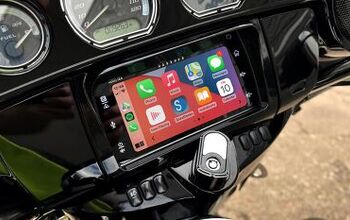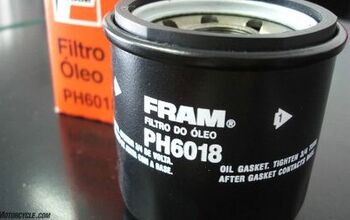Can You Plug a Motorcycle Tire?
Yes, absolutely! But read our complete guide before doing it yourself
Question: Can you plug a tubeless motorcycle tire? Answer: Yes, absolutely! If you put enough miles on your bike, you're bound to face a puncture or two along the way. Nails, screws, and other roadway debris will try their best to spoil a Sunday ride, but a plug can get you back to civilization without too much effort. While these fixes are perfectly safe if performed correctly, not all punctures are suitable for repair. Get out your pencils and notebooks because today we will discuss everything you need to know about plugging tubeless motorcycle tires.
Plug vs. Plug-Patch: What's the Difference?
There are various plugging and patching products on the market, which will typically fit conveniently within under-seat/under-tail storage or stow away in luggage. Everything from classic rubber-cement-slathered rubber rope-styled plugs, mushroom plugs, or liquid-sealing products are available. Each of these solutions has its positives and negatives. For example, the rope-style plug is so simple even a MOron can install it, and they're commonly found in auto parts stores or gas stations. Mushroom plugs are slightly more time-consuming while liquid-sealing products can be messy.
Regardless, all these products work to plug a hole and stop a leak. Most importantly, these solutions can be used while the motorcycle's tire/wheel is still in place. Another thing to remember when choosing your roadside repair solution is how to fill the tire with air again. If an air compressor isn't handy, you've got compressed CO2 cartridges, portable electric pumps, or good old-fashioned hand pumps. So, plan accordingly.
We must mention that some tire manufacturers err on the side of caution and don't suggest repairs of any kind. Their solution? Phone your preferred roadside assistance partner and slap on a new tire at the dealership. That can be costly and sometimes isn't feasible, depending on your location, timing, and other factors.
This isn't a case of "Big Tire" trying to squeeze the common folk for another sale, but a case of being unable to weigh the variables of any given puncture or repair methods that might put a rider's safety at risk. Put simply, we're talking liability, folks.
Tire manufacturers that condone conventional plug repairs view them as temporary fixes. Also, installing a plug or a plug-patch may nullify the speed rating, and we suggest abiding by the limits described on the plug kit's packaging. Typically, the suggested maximum speeds are 50 mph within the first 24 hours of a repair, increasing to a maximum of 80 mph afterward. In either case, these speeds could be significantly lower than what your tire’s rating achieves, not to mention your bike’s performance. Still, 80 mph is well above most posted speed limits in the United States.
Using words like temporary can create uncertainty in the conversation, but since every tire manufacturer has a specific stance on the subject, it's best to consult them directly. In fact, we’ve got the recommendations from one tire manufacturer right here.
One of the few repairs that some tire manufacturers view as permanent solutions is the combination plug-patch, often simply called a patch, which offers two sealing methods. A plug-patch is installed on the tire's interior, with its plug filling the puncture and a patch acting as a backup seal. However, that does mean that the tire needs to be completely unmounted from the rim, which most people will not be able to do on the side of the road. As far as tire repairs go, this is about as good as it gets.
We suggest using a temporary plug to get back home or to a dealership, then having an authorized technician install a combination plug-patch or a new tire.
When Can We Use Plugs and Patches?
So when is it appropriate to use plugs and patches? Well, there are a few variables to consider, such as location, type of puncture, and size.
Slashes, gashes, tears, delamination, and odd-shaped damage also mean that a repair is out of the question – if that's your situation, then get ready to toss that hoop in the recycling pile. Basically, anything that isn't a round hole from a nail, screw, or similarly pointy object is probably not going to be repairable.
Tire makers advise that plugs and patches only be used in the crown of the tire, accounting for roughly 75 percent of the tread – that area can change depending on the maker and type of tire, too. There's good reason for that since the shoulders deform too much, and a plug could potentially break its seal or become dislodged. The sidewall is also a hard no-go zone for similar reasons: It constantly flexes, and a plug won’t stay put. Even worse, damage to the sidewall may have compromised the integrity.
Diving a little deeper, we have puncture size. Most tire makers suggest plugging punctures up to about 6mm. Again, these figures can change depending on the tire producer and the type of repair kit you’re using. As luck would have it, that's roughly the diameter range you'd see left behind from common nails or screws picked up on the street.
Finally, there's tread depth, and we must apologize for the slew of numbers we’ll be discussing here in advance. Tire manufacturers that approve repairs and kit makers often cite a minimum of 1/16 inch (1.5mm) of tread simply because a plug needs a healthy amount of rubber to seal against.
For context, manufacturers commonly suggest replacing your tire once you’ve worn the tread down to 1/32 or 0.8mm. Federal and state regulations tread minimums hover between 1/32 (0.8mm) and 2/32 (1.6mm). The average sport-touring tire tread measures 4.5-5.5mm in the front and 7-8mm in the rear. Meanwhile, chunky ADV rubber can have a significantly deeper tread depth than that. The overall theme is that it might be time for freshies if you’re edging toward any of those lower suggested or legal limits. So, don’t hold onto what’s already on the way out just to save a few bucks.
Don't let flat tires get you down, even if they deflate our enthusiasm a bit (heh). Plugging a tire is something that all riders will need to do at some point in their careers, and if done within the manufacturer-suggested parameters, it will be safe to ride to your nearest service center. As always, follow the repair kit's instructions and consider your tire manufacturer's suggested practices since they'll pertain to whatever solution you are packing. Ride on, MOrons!
Become a Motorcycle.com insider. Get the latest motorcycle news first by subscribing to our newsletter here.
More by Edward Narraca


































Comments
Join the conversation
here is updated about Kawasaki you can check from here
Please read what I wrote. First I commented on the now commonly minimal tools in tool kits. Then I commented that modern riders seem to have little care to learn or perform their own service.
I do feel for most flats a plug that can be installed in the tire while the wheel is on the bike is a good fix. What percentage of riders do you think are willing to install that plug as compared to those that would call for help? probably a tow.
I feel I am well aware of the decline in mechanical interest and ability of most modern riders of any brand. BTW, I am a retired high school voc ed teacher as well as a long time BMW owner. I have observed the decline in BMW owners manuals also, they are now quite minimal and largly suggest dealer service.